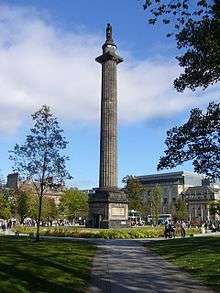Melville Monument, Edinburgh
The Melville Monument is a 150-foot high monumental column. One of the most prominent memorials in Edinburgh, it commemorates Henry Dundas, 1st Viscount Melville, whose statue surmounts the column.

The Category A listed column dominates St Andrew Square, in the heart of the New Town which Dundas helped to establish. It was erected in 1821, 14 years after his death. The architect was William Burn. The statue was added in 1828. The plaque at the base of the statue says the monument was paid for by officers and men of the Royal Navy.
Conservation
In 2008 the Melville Monument was restored as part of the Twelve Monuments Project, a joint initiative of Edinburgh World Heritage and the City of Edinburgh Council.[1]
Controversy over Dundas and the abolition movement
On June 7, 2020, during a Black Lives Matter protest, the Melville Monument was graffitied. Demonstrators believed Dundas had caused a 15-year-delay in Parliament voting to abolish the slave trade.[2]
The leading proponent of the movement to denounce Henry Dundas is Sir Geoff Palmer, a human rights activist and retired science professor at Heriot-Watt University in Edinburgh. He argues that because Henry Dundas proposed an amendment to a motion before the House of Commons in 1792 to achieve abolition gradually, rather than immediately, he delayed abolition of the slave trade by 15 years.[3] His interpretation of events is contested by at least two historians - Brian Young of Oxford University and Michael Fry, biographer of Henry Dundas. They note that the motion to abolish slavery was heading for certain defeat in the House of Commons until Dundas proposed the amendment for gradual abolition, to be achieved by 1800, but that after the successful vote in the House of Commons the House of Lords declined to consider the matter.[4]
As a lawyer, Dundas also won a landmark case in the abolition of slavery in Scotland. In Knight v Wedderburn, he represented a slave who had been brought to Scotland, and who wanted to be freed. He successfully appealed Knight's case, twice, ultimately achieving a victory against slavery when Scotland's highest court decided that no person could be a slave on Scottish soil. The decision effectively achieved emancipation of every slave in Scotland.[5]
In culture
Jack Docherty's short story "Statuesque", centred on this statue, was broadcast by BBC Radio 4 on 28 June 2020 in its Short Works series of stories inspired by current events.[6]
References
- "The Melville Monument". Retrieved 2020-05-02.
- BBC News (8 June 2020). "George Floyd protests: The statues being defaced". BBC. Retrieved 6 July 2020.
- Euro News (11 June 2020). "Sir Geoff Palmer: 'Don't take down statues – take down racism'".
- BBC News for Edinburgh, Fife and East (14 June 2020). "Henry Dundas descendant defends ancestor's record". BBC News. Retrieved July 6, 2020.
- Joseph Knight, a Negro, v John Wedderburn, Esq. [1778] Hailes 776 (15 January 1778) https://www.bailii.org/scot/cases/ScotCS/1778/Hailes020776-0472.pdf
- "BBC Radio 4 - Short Works, Statuesque". BBC. Retrieved 28 June 2020.
External links
| Wikimedia Commons has media related to Melville Monument, Edinburgh. |